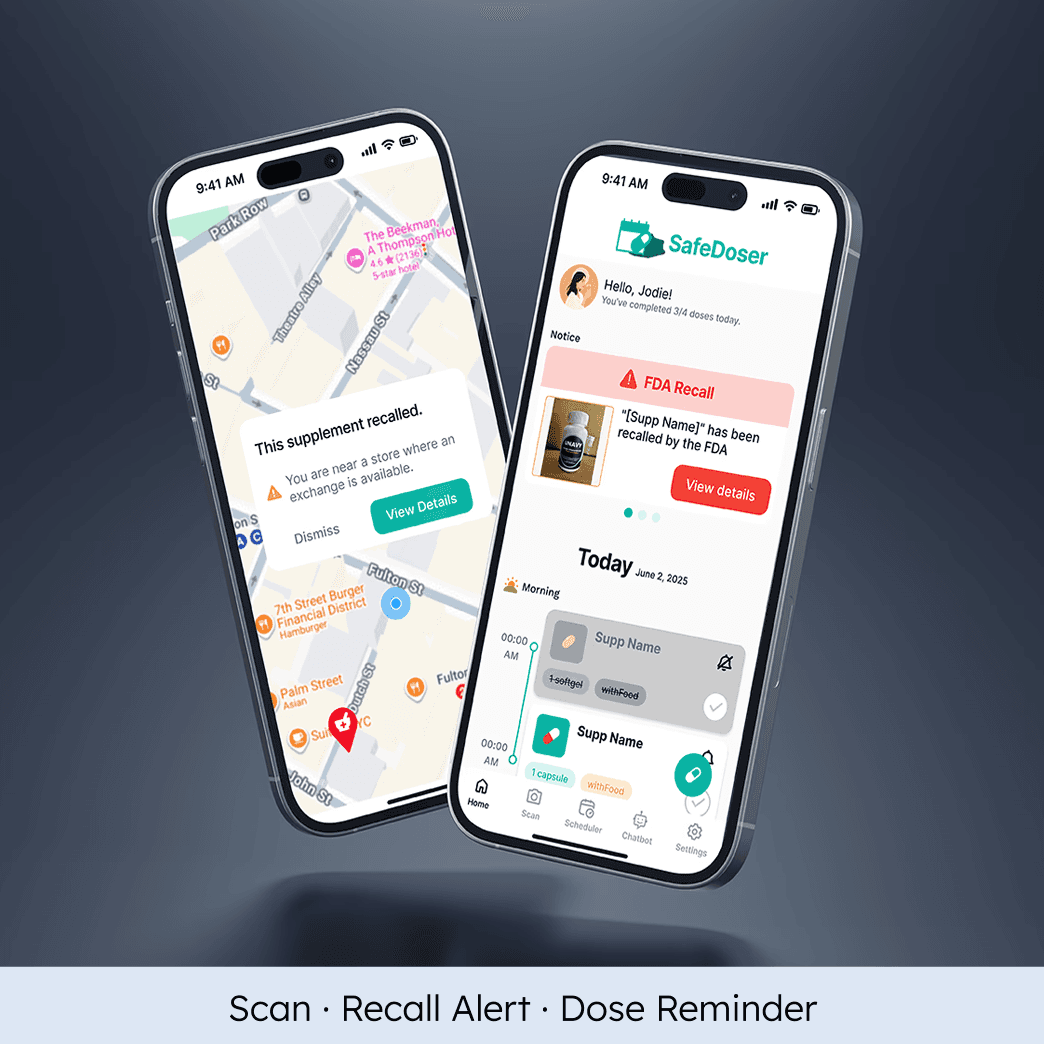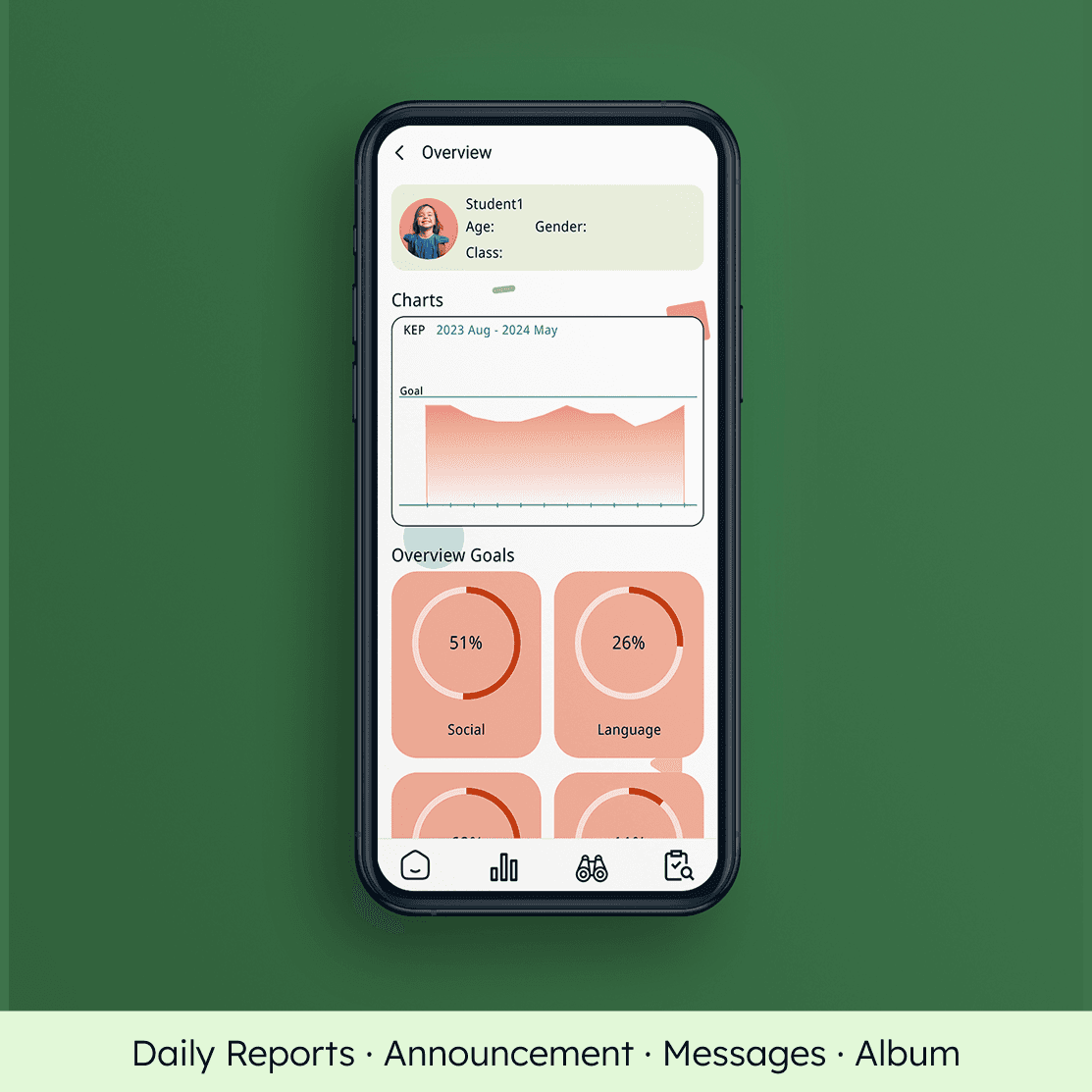Mavo
Mavo
Mavo
Designing MaVo: where sound, story, and trust meet
Designing MaVo: where sound, story, and trust meet
Designing MaVo: where sound, story, and trust meet
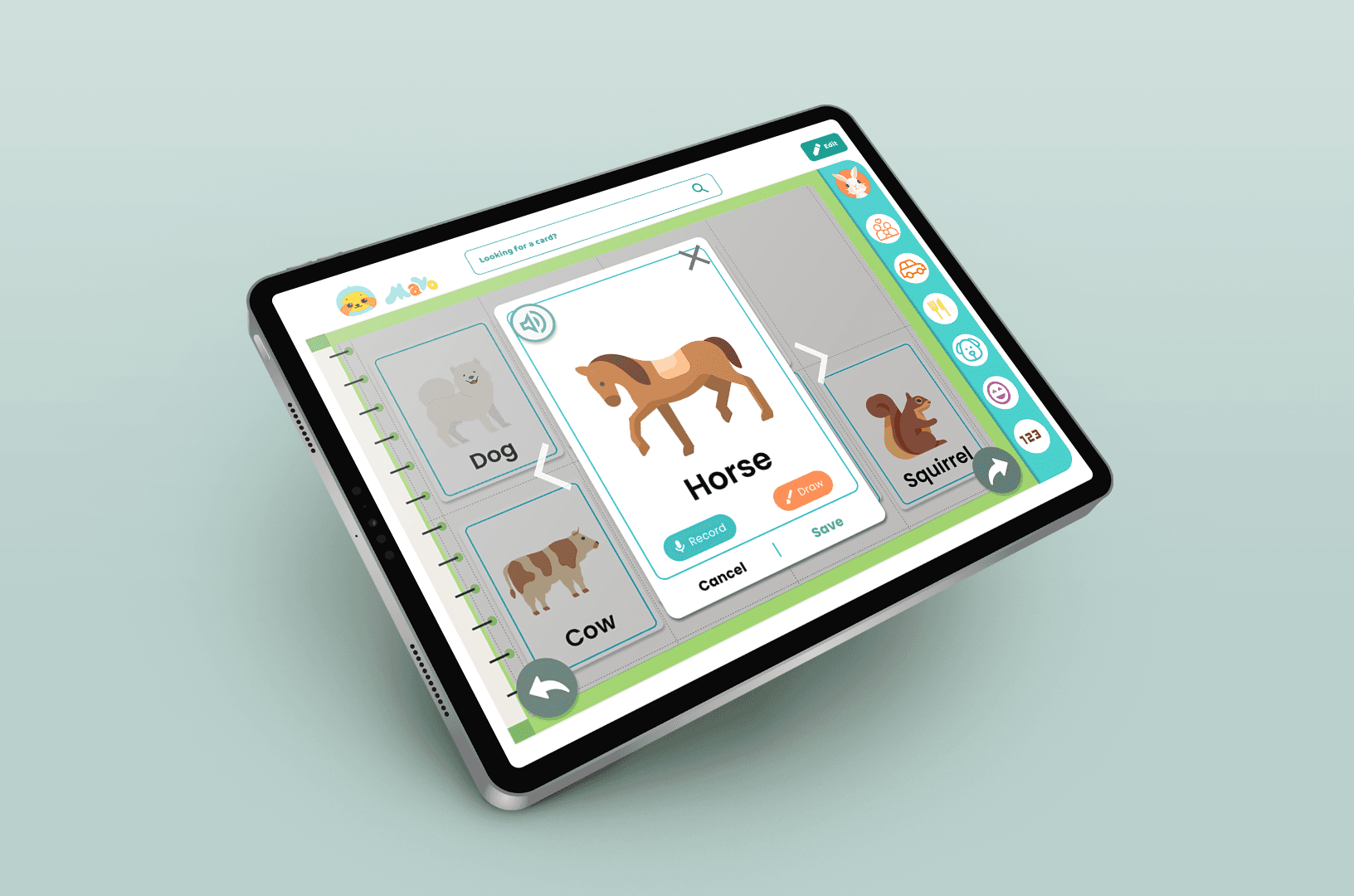

Individual Project
Individual Project
Individual Project
Role: Product designer(research, UX design, prototyping)
Role: Product designer(research, UX design, prototyping)
Role: Product designer(research, UX design, prototyping)
DURATION
DURATION
DURATION
NOV 2024
NOV 2024
NOV 2024
TOOLS
TOOLS
Figma, ProtoPie
Figma, ProtoPie
When learning loses emotion, expression disappears
When learning loses emotion, expression disappears
When learning loses emotion, expression disappears
Imagine a child who understands the world through sound and touch but cannot yet speak. They recognize their guardians’ voice, draw pictures to share feelings, and react to music with joy, yet most word learning tools treat them like every other learner.
Imagine a child who understands the world through sound and touch but cannot yet speak. They recognize their guardians’ voice, draw pictures to share feelings, and react to music with joy, yet most word learning tools treat them like every other learner.
Imagine a child who understands the world through sound and touch but cannot yet speak. They recognize their guardians’ voice, draw pictures to share feelings, and react to music with joy, yet most word learning tools treat them like every other learner.
We saw this gap across non-verbal children and their caregivers. Existing apps focus on repetition and vocabulary drills, but few help children feel emotionally connected or motivated to express themselves.
We saw this gap across non-verbal children and their caregivers. Existing apps focus on repetition and vocabulary drills, but few help children feel emotionally connected or motivated to express themselves.
We saw this gap across non-verbal children and their caregivers. Existing apps focus on repetition and vocabulary drills, but few help children feel emotionally connected or motivated to express themselves.
What’s the problem?
What’s the problem?
What’s the problem?
Personalized voices and child-created visuals increased speaking attempts and focus by over 40%.
Personalized voices and child-created visuals increased speaking attempts and focus by over 40%.
Personalized voices and child-created visuals increased speaking attempts and focus by over 40%.
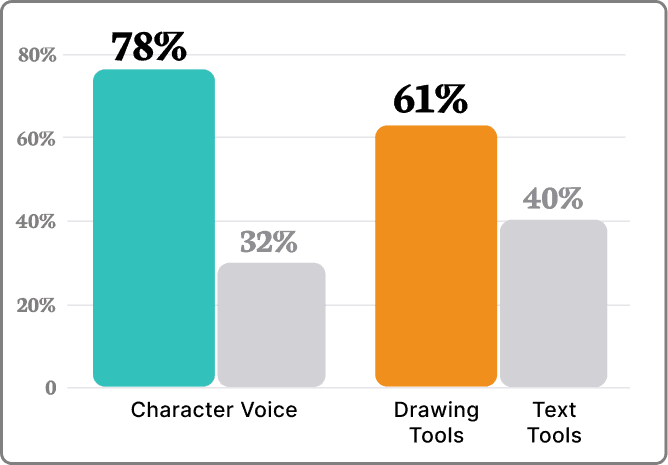


Non-verbal children struggle to stay engaged with existing word-learning tools that rely on generic voices and text-based prompts.
Non-verbal children struggle to stay engaged with existing word-learning tools that rely on generic voices and text-based prompts.
Non-verbal children struggle to stay engaged with existing word-learning tools that rely on generic voices and text-based prompts.
The design needed to translate these emotional triggers into an adaptive learning interface.
The design needed to translate these emotional triggers into an adaptive learning interface.
The design needed to translate these emotional triggers into an adaptive learning interface.
What’s the solution?
What’s the solution?
What’s the solution?
Redefine word learning as an emotional interaction rather than pure instruction.
Redefine word learning as an emotional interaction rather than pure instruction.
Redefine word learning as an emotional interaction rather than pure instruction.
Non-verbal children often disengage with rigid, text-based learning tools.
Non-verbal children often disengage with rigid, text-based learning tools.
Non-verbal children often disengage with rigid, text-based learning tools.
To help them build trust and motivation, Mavo focuses on familiar voices, creative ownership, and gentle sensory feedback, turning practice into an emotionally guided experience that feels safe and playful.
To help them build trust and motivation, Mavo focuses on familiar voices, creative ownership, and gentle sensory feedback, turning practice into an emotionally guided experience that feels safe and playful.
To help them build trust and motivation, Mavo focuses on familiar voices, creative ownership, and gentle sensory feedback, turning practice into an emotionally guided experience that feels safe and playful.
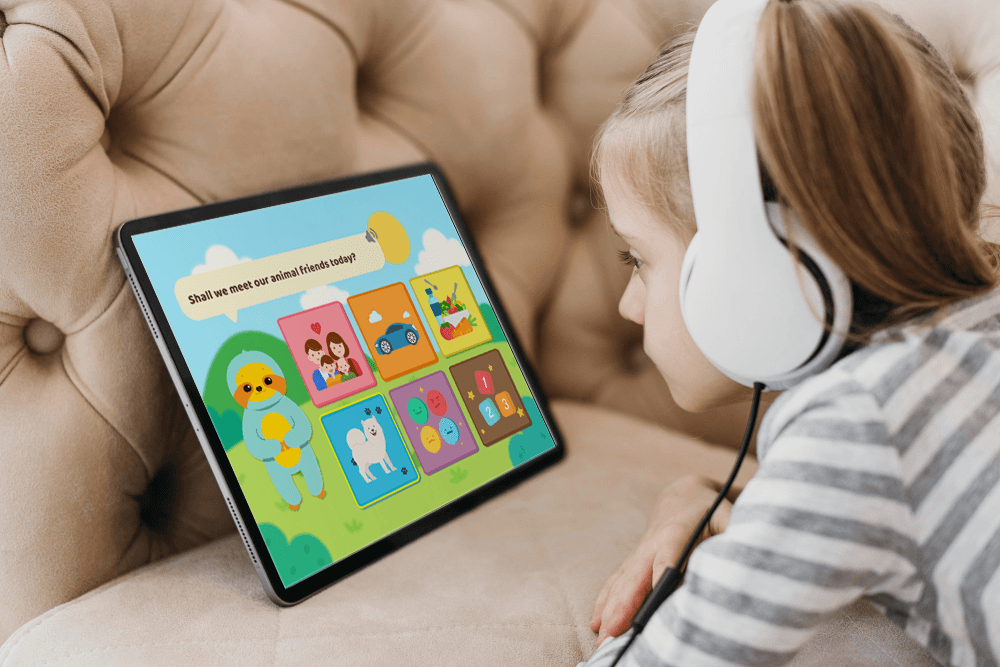


Discovery & Insight Synthesis
Discovery & Insight Synthesis
Discovery & Insight Synthesis
Understanding why engagement fades
Understanding why engagement fades
Understanding why engagement fades
I analyzed existing AAC and word-learning tools to understand why non-verbal children struggle to stay engaged.
I analyzed existing AAC and word-learning tools to understand why non-verbal children struggle to stay engaged.
I analyzed existing AAC and word-learning tools to understand why non-verbal children struggle to stay engaged.
Most tools rely on text-to-speech repetition, focusing on communication output rather than emotional input.
Most tools rely on text-to-speech repetition, focusing on communication output rather than emotional input.
Most tools rely on text-to-speech repetition, focusing on communication output rather than emotional input.
While these apps help children name things, they often fail to build emotional connection or motivation to express themselves.
While these apps help children name things, they often fail to build emotional connection or motivation to express themselves.
While these apps help children name things, they often fail to build emotional connection or motivation to express themselves.
competitive analysis
competitive analysis
competitive analysis



From findings to design opportunities
From findings to design opportunities
From findings to design opportunities
Research revealed that engagement increases when learning feels emotionally familiar, personally owned, and creatively expressive.
Research revealed that engagement increases when learning feels emotionally familiar, personally owned, and creatively expressive.

Emotional connection keeps children engaged
Emotional connection keeps children engaged
Familiar voices foster a sense of safety and focus.
Familiar voices foster a sense of safety and focus.
Familiar voices foster a sense of safety and focus.

Personalization increases motivation
Personalization increases motivation
Letting children draw or record helps them stay emotionally connected.
Letting children draw or record helps them stay emotionally connected.
Letting children draw or record helps them stay emotionally connected.

Creative interaction fosters expression
Creative interaction fosters expression
CREATIVE iNTERACTION fOSTERS sELF EXPRESSION
Playful creation encourages speech attempts beyond instruction.
Playful creation encourages speech attempts beyond instruction.
Creative interactions like drawing and play let non-verbal children express themselves without speech
These insights shaped the foundation for an adaptive, emotionally responsive interface.
These insights shaped the foundation for an adaptive, emotionally responsive interface.
These insights shaped the foundation for an adaptive, emotionally responsive interface.
User Journey map
User Journey map
User Journey map
Understanding emotional friction in learning
Understanding emotional friction in learning
Understanding emotional friction in learning
Observing how non-verbal children interact with AAC tools revealed emotional friction points across the learning journey.
Observing how non-verbal children interact with AAC tools revealed emotional friction points across the learning journey.
Observing how non-verbal children interact with AAC tools revealed emotional friction points across the learning journey.
They often begin curious but disengage when voice feedback feels robotic or repetitive.
They often begin curious but disengage when voice feedback feels robotic or repetitive.
They often begin curious but disengage when voice feedback feels robotic or repetitive.
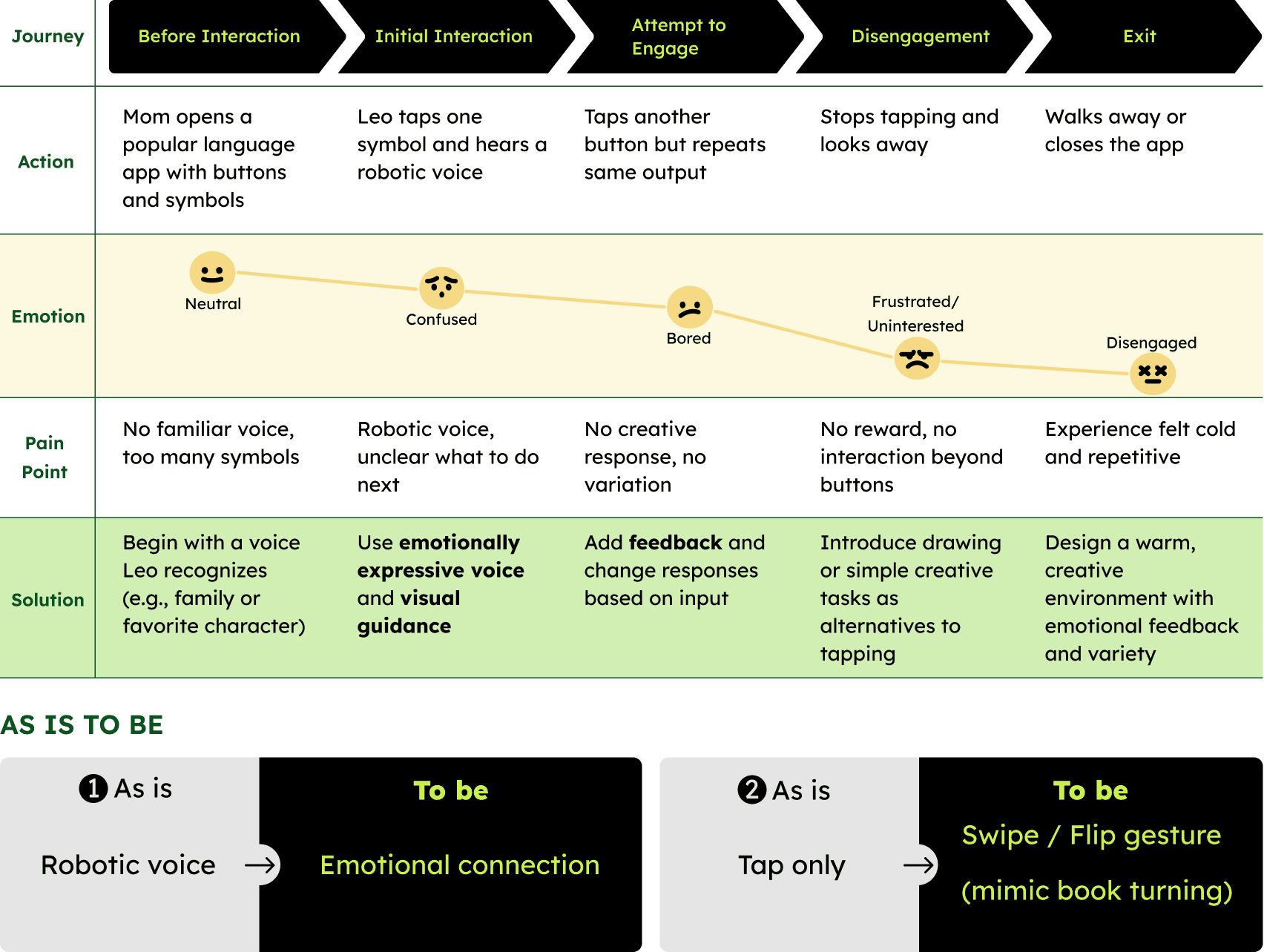


"How might we help non-verbal children build emotional engagement with word learning, so that speech attempts feel natural and playful?"
"How might we help non-verbal children build emotional engagement with word learning, so that speech attempts feel natural and playful?"
This question guided the next phase of defining design principles and interaction patterns.
"How might we help non-verbal children build emotional engagement with word learning, so that speech attempts feel natural and playful?"
This question guided the next phase of defining design principles and interaction patterns.
This question guided the next phase of defining design principles and interaction patterns.
What do users need to stay emotionally engaged?
What do users need to stay emotionally engaged?
What do users need to stay emotionally engaged?
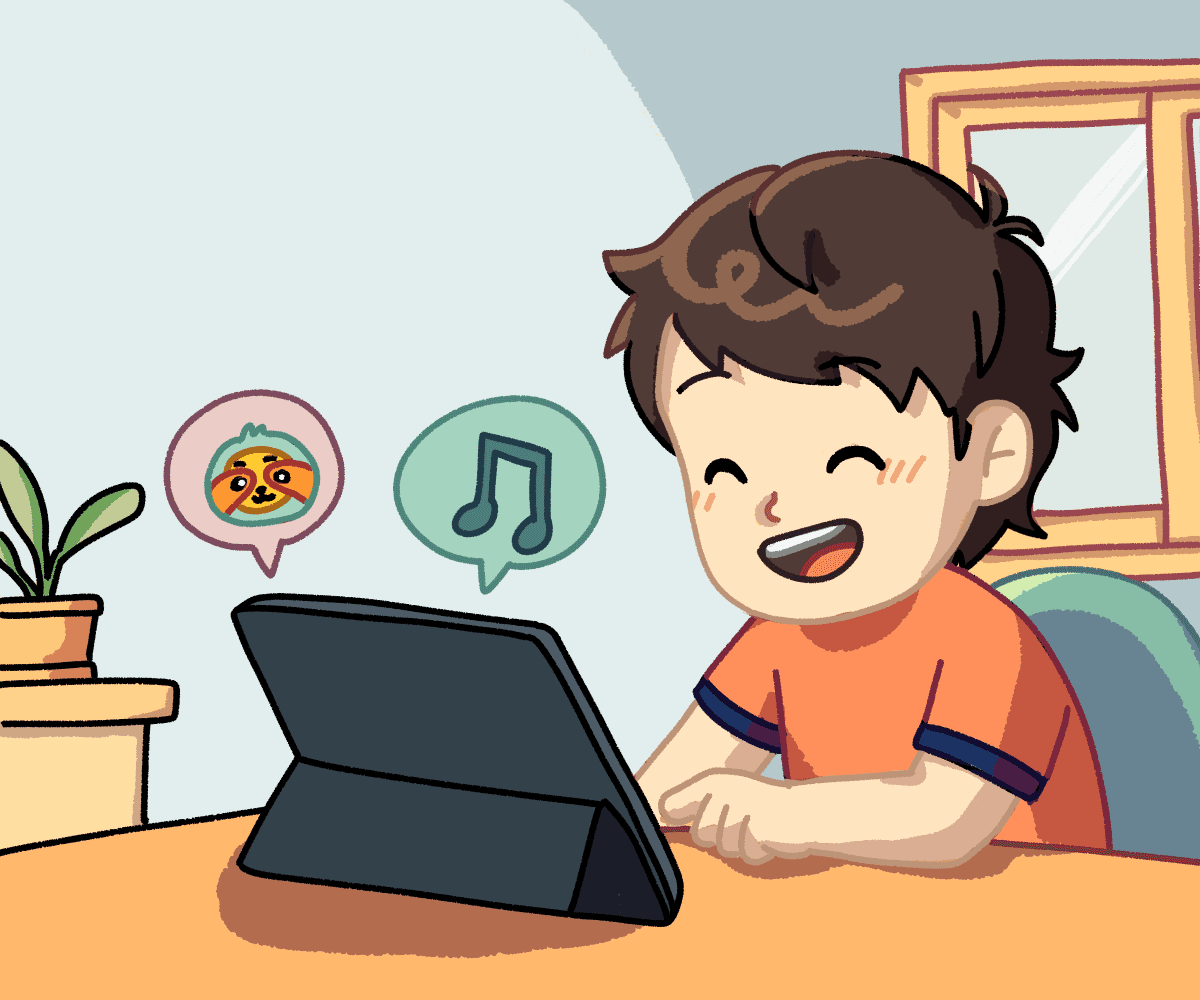


emotional connection builds confidence
Emotional connection builds confidence
emotional connection builds confidence
Children focus longer when they hear familiar voices and experience warmth in tone and pacing.
Children focus longer when they hear familiar voices and experience warmth in tone and pacing.
Children focus longer when they hear familiar voices and experience warmth in tone and pacing.
Personalization increases motivation
Personalization increases motivation
Personalization increases motivation
Letting children draw or record helps them stay emotionally connected.
Letting children draw or record helps them stay emotionally connected.
Letting children draw or record helps them stay emotionally connected.
Creative interaction fosters expression
Creative interaction fosters expression
Creative interaction fosters self-expression
Playful creation encourages speech attempts beyond instruction.
Playful creation encourages speech attempts beyond instruction.
Creative interactions like drawing and play let non-verbal children express themselves without speech
From Recognition to Emotional Connection
From Recognition to Emotional Connection
From Recognition to Emotional Connection
The learning flow was designed to feel personal, sensory, and emotionally guided.
This flow combines recognition and ownership, familiar voices and child-created drawings, making practice feel personal and meaningful rather than mechanical.
This flow combines recognition and ownership, familiar voices and child-created drawings making practice feel personal and meaningful rather than mechanical.
The interface flow connects recognition and creation, combining voice, drawing, and feedback loops into a single adaptive experience.



Screen flow
Screen flow
Screen flow
The screen flow connects recognition, creation, and feedback into one continuous learning loop.
The screen flow connects recognition, creation, and feedback into one continuous learning loop.
The screen flow connects recognition, creation, and feedback into one continuous learning loop.



Prototyping the Experience
Prototyping the Experience
Prototyping the Experience
Hi-fi prototypes visualized how emotional familiarity and creative ownership could turn learning into personal and playful interactions.
Hi-fi prototypes visualized how emotional familiarity and creative ownership could turn learning into personal and playful interactions.
Hi-fi prototypes visualized how emotional familiarity and creative ownership could turn learning into personal and playful interactions.
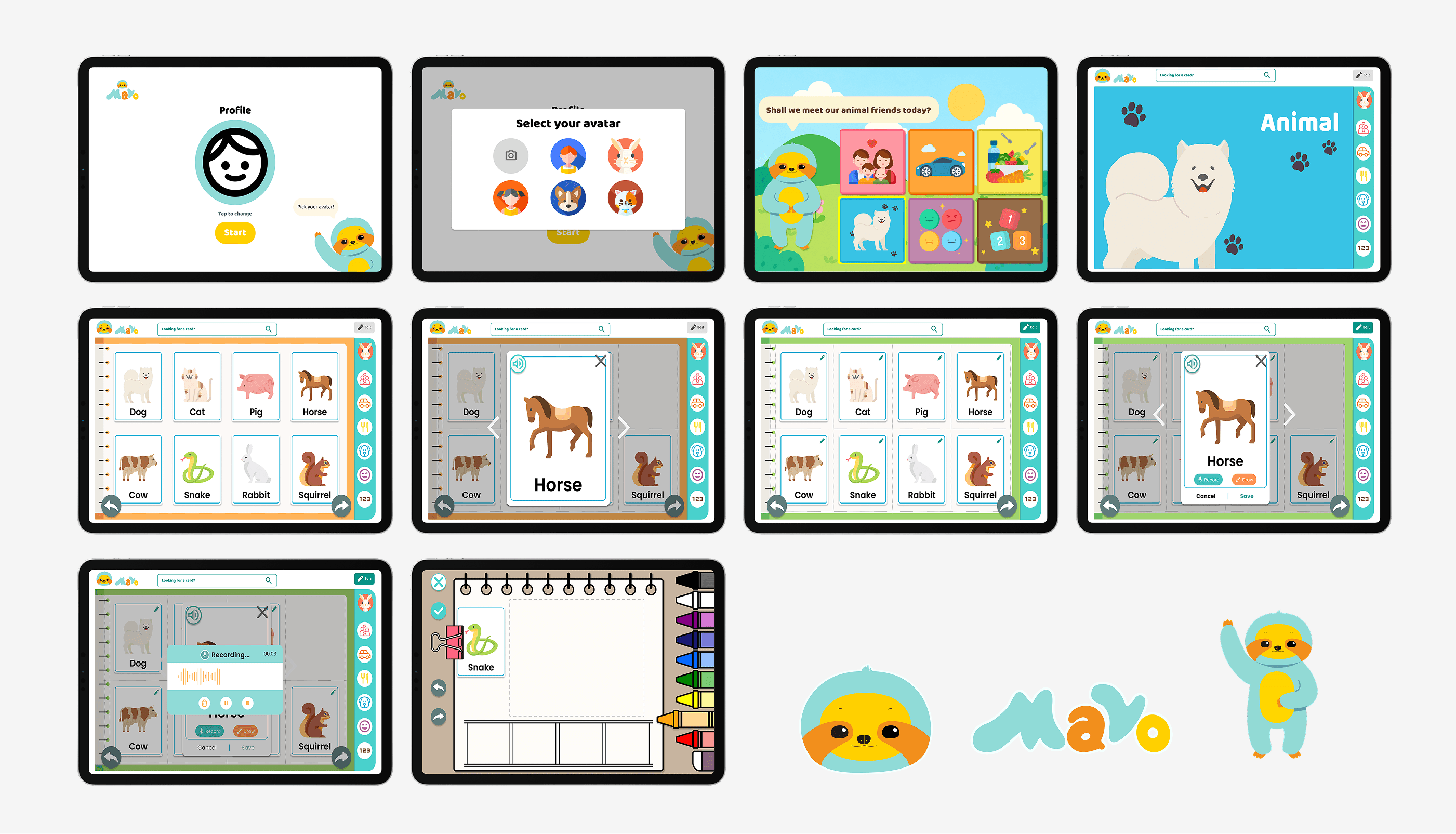


User Testing & Iterations
User Testing & Iterations
User Testing & Iterations
Quick usability tests revealed that children expected sensory feedback such as card-flip sounds and simpler labels for guardians.
Quick usability tests revealed that children expected sensory feedback such as card-flip sounds and simpler labels for guardians.
Quick usability tests revealed that children expected sensory feedback such as card-flip sounds and simpler labels for guardians.
Iterations simplified the interface, reduced steps, and made interactions more emotionally responsive.
Iterations simplified the interface, reduced steps, and made interactions more emotionally responsive.
Iterations simplified the interface, reduced steps, and made interactions more emotionally responsive.
Learnings:
Learnings:
Learnings:
Speech motivation is ineffective without emotional engagement.
Flexibility through drawings and recordings enables more personalized learning.
Speech motivation is ineffective without emotional engagement.
Flexibility through drawings and recordings enables more personalized learning.
Speech motivation is ineffective without emotional engagement.
Flexibility through drawings and recordings enables more personalized learning.
Key Interaction
Key Interaction
Key Interaction
Learning that moves at a child's rhythm
Learning that moves at a child's rhythm
Learning that moves at a child's rhythm
Mavo turns digital word learning into a tactile, emotionally guided experience.
Mavo turns digital word learning into a tactile, emotionally guided experience.
Mavo turns digital word learning into a tactile, emotionally guided experience.
Children swipe or tap to flip cards and hear familiar voices, building a sense of progress and connection through gentle, rhythmic motion.
Children swipe or tap to flip cards and hear familiar voices, building a sense of progress and connection through gentle, rhythmic motion.
Children swipe or tap to flip cards and hear familiar voices, building a sense of progress and connection through gentle, rhythmic motion.



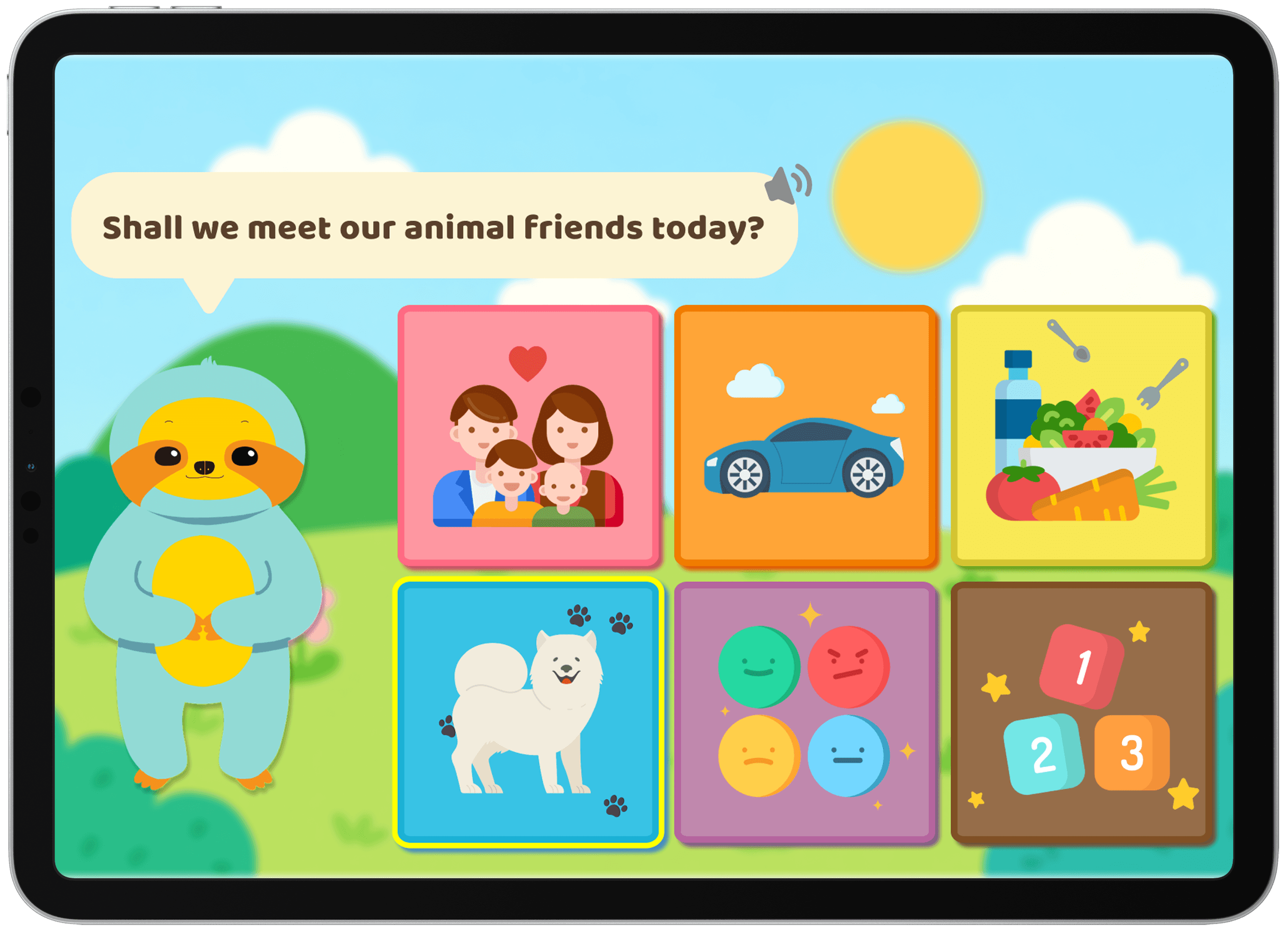
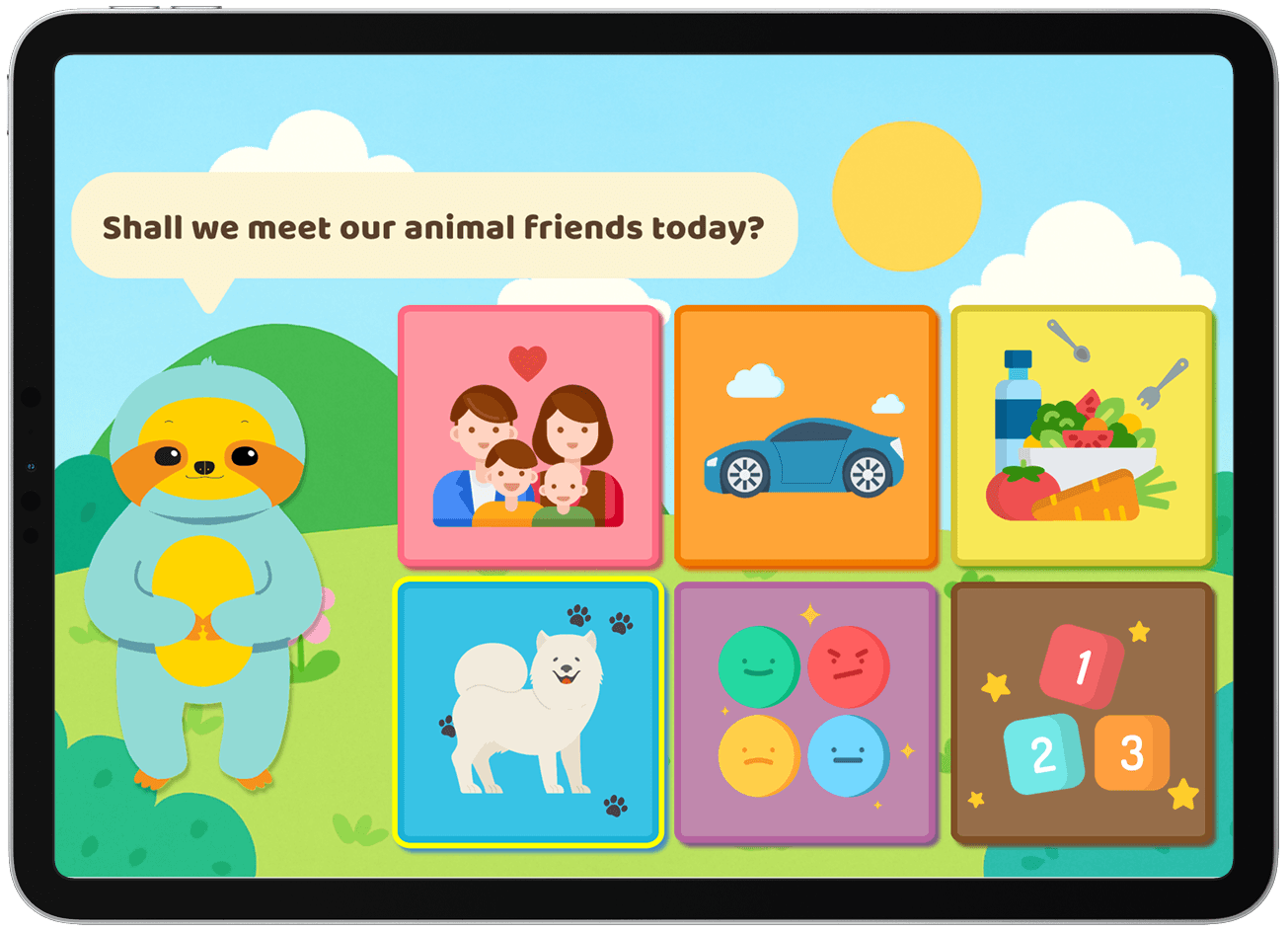

Learning that feels like a conversation
Learning that feels like a conversation
Learning that feels like a conversation
Mavo introduces a friendly mascot that greets children with warm voice prompts and gentle encouragement.
Mavo introduces a friendly mascot that greets children with warm voice prompts and gentle encouragement.
Mavo introduces a friendly mascot that greets children with warm voice prompts and gentle encouragement.
Each interaction feels like a shared dialogue, helping non-verbal children stay engaged and emotionally supported as they learn.
Each interaction feels like a shared dialogue, helping non-verbal children stay engaged and emotionally supported as they learn.
Each interaction feels like a shared dialogue, helping non-verbal children stay engaged and emotionally supported as they learn.
Reflection
Reflection
Reflection
Designing emotion, not instruction
Designing emotion, not instruction
Designing emotion, not instruction
Through testing, I learned that emotional design is not about adding features, but about pacing, tone, and trust.
Through testing, I learned that emotional design is not about adding features, but about pacing, tone, and trust.
Through testing, I learned that emotional design is not about adding features, but about pacing, tone, and trust.
Simple, consistent feedback helped children stay engaged longer than complex visuals or gamified tasks.
Simple, consistent feedback helped children stay engaged longer than complex visuals or gamified tasks.
Simple, consistent feedback helped children stay engaged longer than complex visuals or gamified tasks.
Next
Next
Next
I plan to expand Mavo with personalized voice recording and drawing tools to strengthen connection and motivation between children and caregivers.
I plan to expand Mavo with personalized voice recording and drawing tools to strengthen connection and motivation between children and caregivers.
I plan to expand Mavo with personalized voice recording and drawing tools to strengthen connection and motivation between children and caregivers.
